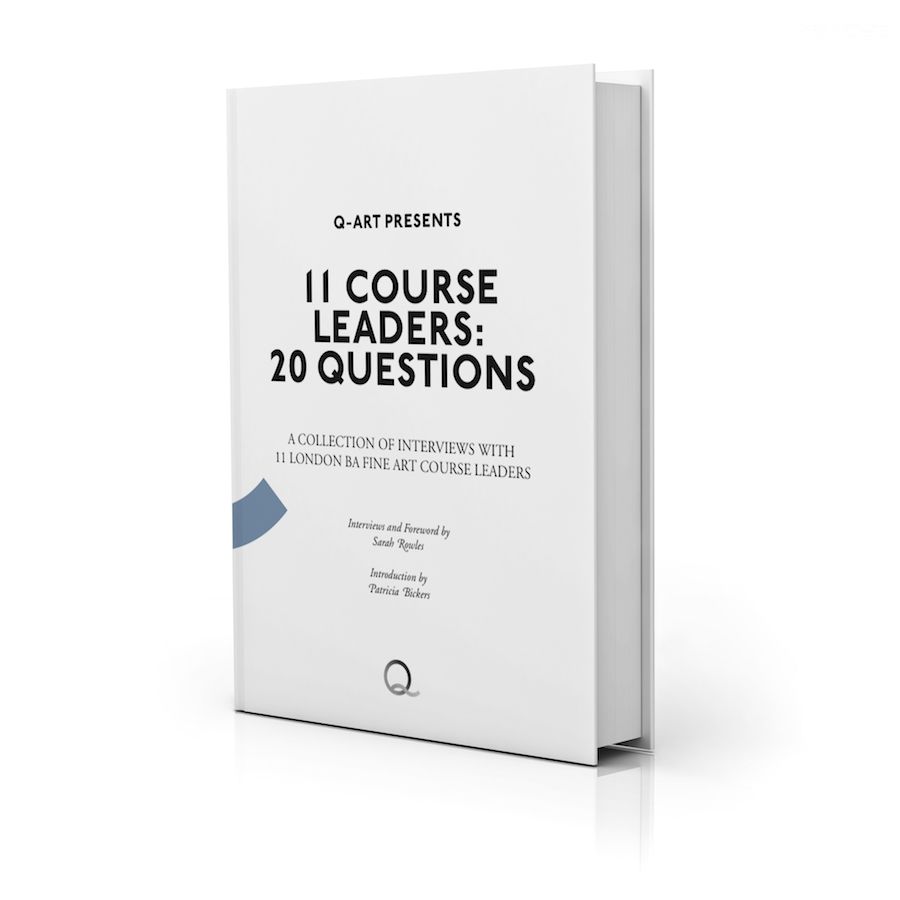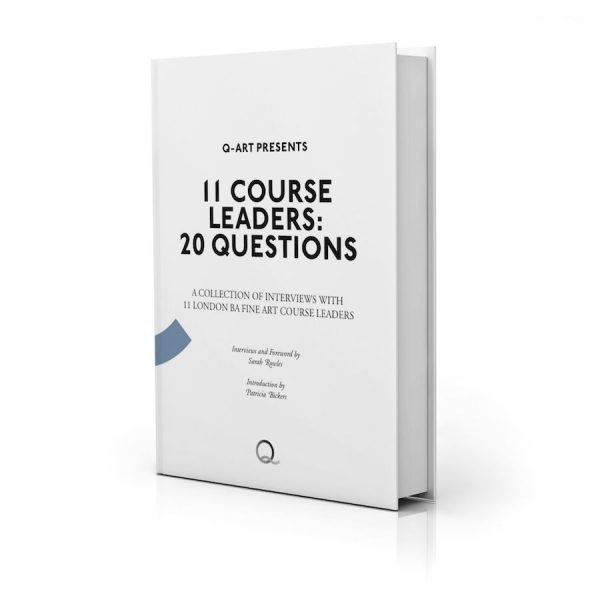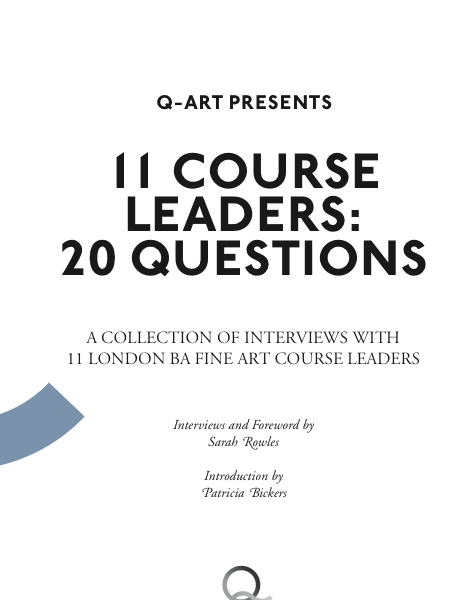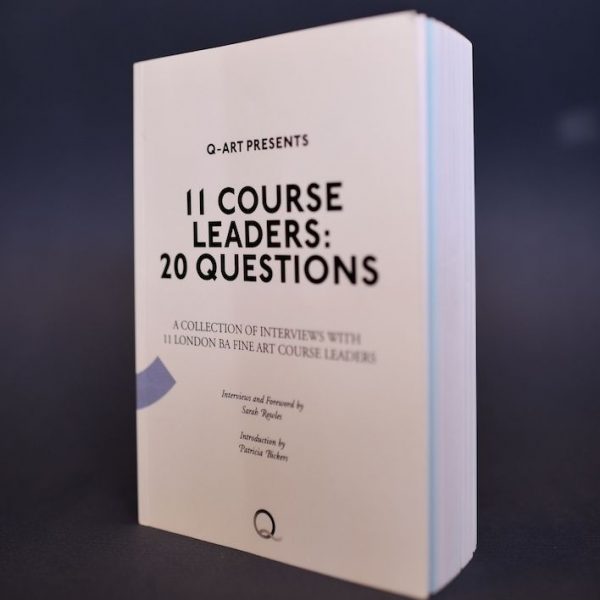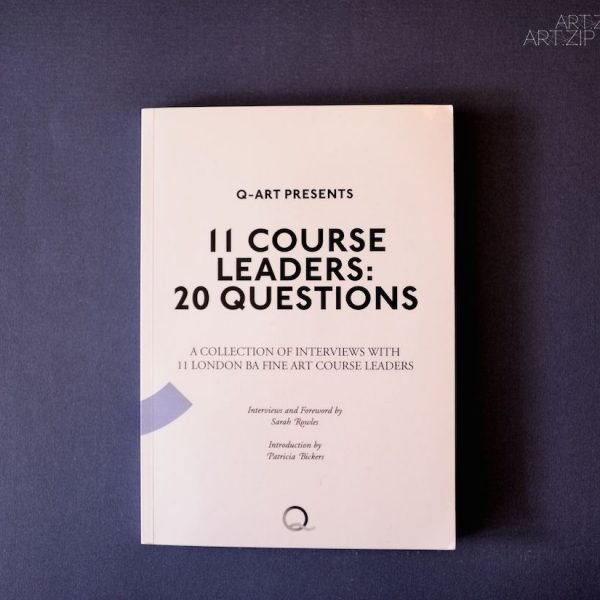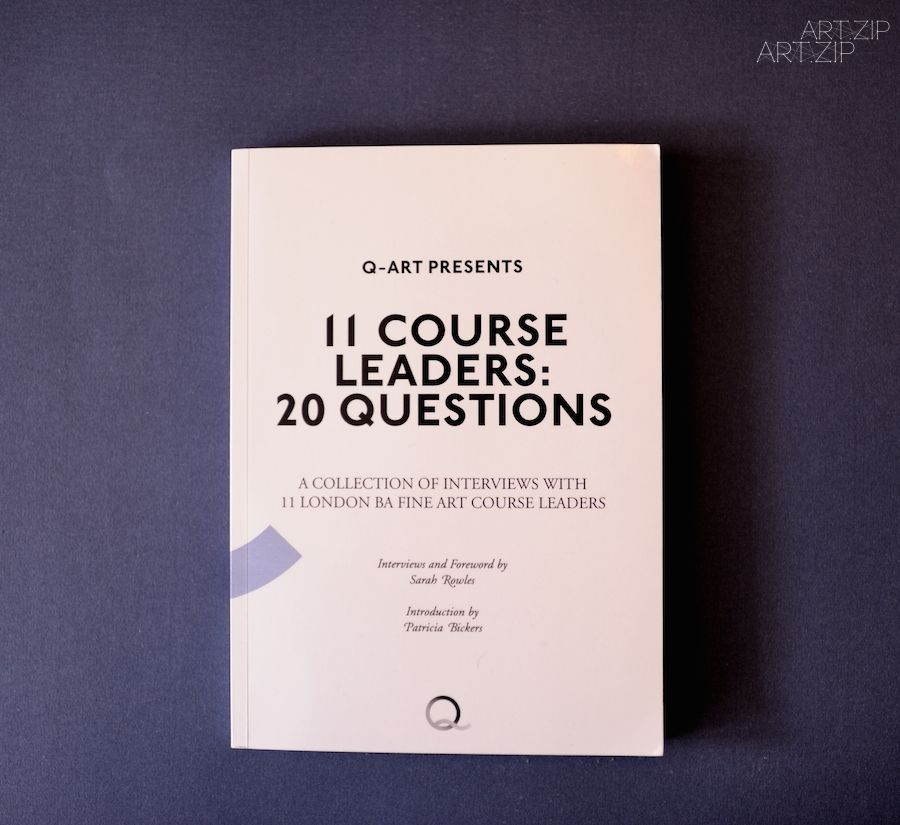
11 Course Leaders: 20 Questions – A collection of Interviews with 11 London BA Fine Art Course
Leaders
《倫敦藝術課程主任二十問》
Text by: Peng Zuqiang
撰文: 彭祖強
.
There seems to be a rather redundant amount of discussion on the future of art education at a higher level. During the age of crisis, one of the most debated questions was whether it would still be worthwhile to study art after UK tuition fee increases and with the market showing signs of fatigue.
近幾年來,在英國關於大學藝術教育的討論尤其熱烈。在經濟乏力的年頭,學生和學校所共同面對的最常見問題便是:在藝術市場萎縮的年代,來大學學習藝術專業到底值不值。
In a way, the book 11 Course Leaders: 20 Questions – A collection of Interviews with 11 London BA Fine Art Course Leaders, attempts to provide a series of responses to this question. The book, as its title suggests, takes the format of interviews, with the author Sarah Rowles asking the leaders of 11 BA Fine Art courses in London 20 questions each. These questions, some drafted before-hand and some of which emerge during the conversations, are intended to demystify undergraduate art education from multiple perspectives.
而三年前出版的《倫敦藝術課程主任二十問》(下文簡稱為《二十問》),則正是想給所提及的這個問題給出回應。《二十問》, 書如其名,是一本由作者莎拉·羅斯(Sarah Rowles)對倫敦十一所藝術大學本科純藝專業的課程主任訪問組成的合集。薩拉·羅斯向每位課程主任提出了二十個問題,這十一場對談中,二十個問題各有不同,有些是提前準備,而另一些則是隨著訪談話題的深入而展開。而所有這二十個問題,都給予不同的角度來理解和認識本科階段的藝術教育專業。
Readers who expect this book to list the ‘pros and cons’ of each Fine Art course might, in the long and in-depth interviews, find it is not what they looking for; however, it is not Rowles’ intention to publish a book which serves that purpose. As a graduate of BA Art Practice from Goldsmiths, Sarah Rowles discovered her own interest in investigating models of art education while she was still a student. This book is a result of her sustained passion for art education – an interest which also drives her to run the art education organisation ‘Q-Art’, whose aim is to support people into, through and beyond art education.
可能讀者們會期待這本書成為一本列出各學校優劣的‘擇校手冊’。但這本書所包含的其實是十一組具有深度和長度的訪問。寫一本‘倫敦選校指南’並非薩拉·羅斯的初衷,薩拉·羅斯從金史密斯學院純藝本科畢業,在金史密斯的學習過程中,她對藝術教育自身的結構與其不同的模式產生了興趣。而這本書正是她畢業後這樣一個興趣的延伸,她對藝術教育體系的好奇也促使她創辦了Q-Art這個藝術教育組織,而Q-Art通過出版物、藝術研討會和展覽的方式,為在藝術教育不同階段的受眾提供幫助。
By bringing these 11 London-based art courses together in the same book, this small publication employs no hierarchy – giving equal weight to colleges that are easily overlooked, such as Cass School and City and Guilds, as to those that are more internationally renowned, namely Central Saint Martins. That said, readers are still made aware of the differing educational models practiced in the various art colleges.
這十一組與各個倫敦藝術院校課程主任的對談,沒有按學校的名氣來分配其地位。而其中一些經常被人忽略但同樣優秀的學校:卡斯藝術學院(Cass School)和城市協會藝術大學(City & Guilds of London Art School),也跟另外一些國際知名的學院在這本小小的出版物中占據著同樣重要的位置。但是,這並不意味著訪談的內容有任何大相徑庭,讀者們還是能從中辨別出這些學校所施行的各不相同的教育模式。
For instance, the split in teaching models, between the conceptual-led versus the material-led, can be thought of as a criteria to differentiate art schools. However, in actual fact, most schools do not define themselves so rigidly. When asked about the common stereotype towards the Slade School of Fine Art as the ‘materials-led’ school, the Slade’s then director, Professor John Aiken, refused to identify the school as such, denying any opposition to the conceptual-led model. He referred to alumni, well recognised in the contemporary art world in recent years such as Angela de la Cruz and Tacita Dean, claiming that they both exhibit a highly discursive practice whilst still maintaining incredibly good ‘craft-based’ skills. Aiken does not believe the word ‘skill’ to be the most appropriate word to negotiate definitions of art school, however, he thinks that material culture is strong at the Slade, and the debate surrounding ‘skilling and de-skilling’ is very active in the school.
例如,在純藝專業中,以觀念為創作起點或是以材料為中心曾是一個能區分學校特色的指標。然而,在當今藝術教育中,大部分的學校已經不會再用這樣死板的二分法來定義自己。當被問及如何看待斯萊德美術學院(Slade School of Fine Art)常被看作是‘以材料為創作起點’的學校時,斯萊德的課程主任約翰·艾肯(John Aiken)教授不同意這種簡單的兩兩相對的比較。他舉出學校的知名校友,同時又是近幾年活躍在當代藝術界的藝術家馬丁·克裏德(Martin Creed)和塔其塔·迪恩(Tacita Dean)為例,他們二人均以觀念藝術創作見長,但同時都具有紮實的技巧功底。艾肯教授並不認為‘技巧’是用來衡量藝術教育優劣的最佳詞匯。但同時他也同意對材料的深度鉆研在斯萊德學院是很常見的,而學校裡關於‘技巧’和‘去技巧’的討論也相當的普遍。
This model of ‘first skill, then de-skill’ was too often used on students who came from a non-Western educational background. Aiken gives the example of students from the Far East who, in their undergraduate education at home, experienced a heavy emphasis on learning traditional skills. When they arrived in the UK for their Masters degree, they found the different approach to teaching contemporary art practice very challenging.
這種‘先熟練技巧,再疏遠技巧’的特質,經常被用來形容有著非西方藝術教育背景的學生。比如在東亞地區,很多藝術學生在大學本科階段重視磨練他們的繪畫或雕塑技巧。而當他們到西方來學習藝術研究生學位時,則被一種截然不同的看待當代藝術的角度所挑戰。
This rather outdated East/West split may also have a parallel in to the divided pedagogical pathways of Painting, Sculpture, Photography and New Medias. A more traditional art school in a non-Western region is likely to be organised around such pathways, an approach many art colleges in the West have abandoned, replacing it with a broad-based BA Fine Art course.
類似於這種‘東西教育差別’的過時論調,同樣也出現在專業內部方向的區分上。比如,一些較為傳統的非西方院校可能大多保留著繪畫、雕塑、攝影、新媒體等等諸如此類的方向區分規劃。而在西方的大多數院校已經取消了這些分類,而只開設一門兼容並包的純藝專業。
However, not every art school agrees with the division-less educational model. Wimbledon College of Arts, part of the University of Arts London, still offers subject-specific Fine Art provision. As Dereck Harris, Wimbledon’s BA Fine Art courses leader comments, Wimbledon, as a small and originally independent art college, maintains a friendly and supportive atmosphere, and this works well with subject-specific learning. Wimbledon offers three divisions: Painting, Sculpture and Print & Time-Based Media. Harris discussed how broad-based art courses often promote a ‘prior-conceptualisation’ of art practice, in which the discussion of ideas usually precedes the making process itself. Again this is a question which activates the debate surrounding skill/de-skill and process/concept.
儘管如此,也並不是每所倫敦院校都不再分專業方向。倫敦藝術大學溫布爾登藝術學院(Wimbledon College of Arts),仍然堅持著按方向區分的本科純藝學位。溫布爾登學院的藝術課程主任德雷克·哈裡斯(Dereck Harris)談到,作為一個規模相對較小、同時具有悠久獨立歷史的藝術學校,溫布爾登保留了一個友好而互助的學習氛圍,而這種氛圍對專業分化的設置很重要。溫布爾登學院的本科純藝專業有三個方向:繪畫,雕塑,多媒體。而哈裡斯認為單一而不分方向的專業設置通常會偏向於以觀念為中心的創作模式,而在此之中,對於觀念的辯論往往超越了創作過程本身。而這也是一個有關於‘技巧/去技巧’,‘過程/觀念’的藝術教育大討論。
A division into specialisms also challenges the group critique which is commonly practiced in the broad-based model, where students discuss each others’, work, assumptions and values. Harris thinks this group-critique model can potentially ‘lead to a conceptual, stylistic or attitudinal homogeneity’ which he doesn’t like. Instead, he thinks Wimbledon, with its subject divisions, offers a more democratic and pluralistic approach – one which emphasises diversity.
Whether it is ‘Thinking through Making’, or ‘Making through Thinking’, historically, contemporary art practice and art education also included an art history and critical theory component. This also highlights another key question of BA art education: whether art history and theory should be taught as part of the course. Sarah Rowles first entered Goldsmiths as an student of art history, but changed her mind after studying for a year, instead graduating from the BA Fine Art practice programme. As a graduate who had experienced both disciplines at Goldsmiths, she asked the BA Fine Art course leader Michael Archer the reason for not teaching art history in the practice course.
Michael Archer is not a practicing artist, instead he has a History of Art degree and a prolific career as a critic and writer. Archer agrees that knowledge of art history can benefit anyone who practices art. Nevertheless, he also believes that the studying of art history ‘should not be prioritised over having knowledge of other things.’ For Archer, art history is as important as any other personal or professional development which helps the student to become an artist, whether it is the craft skills of knowing how to paint, or familiarity with the world outside the art college.
有方向區分的專業設置,也是對另一種藝術中‘Convenor’討論會的一種挑戰。哈裡斯認為這種‘Convenor’討論會,會可能引導學生們進入一種‘觀念、風格及態度上的同一性’,而哈裡斯本人並不贊同這種現象。取而代之的,一種更為民主、多元、強調多樣性的教學模式是他所認為溫布爾登學院所能提供的。
無論是‘以思考帶領創作’或是反其道而行之的‘以創作引領思考’的模式,在當代藝術教育中,藝術理論跟創作往往有著緊密的聯繫。這也往往引出另外一個藝術教育的問題,在本科純藝專業裡,需要開設藝術史和藝術理論的課程嗎?這本書的作者薩拉·羅斯最先是以一名藝術史學生的身份來到金史密斯學院,在一年的學習後,她改變主意轉到了純藝專業。作為一名在金史密斯學院對兩門不同專業都有經歷過的畢業生,羅斯問到學院的課程主任邁克爾·阿徹(Michael Archer)為什麽不在純藝術課程裡開設藝術史課程。
邁克爾·阿徹雖然並不是藝術家出身,但擁有藝術史學位的他是一名著作等身的藝評人和作家。阿徹認為藝術史常識對任何一位藝術創作者都有幫助,但他同時也提出對藝術史的學習‘不應被提升至比對其他知識的學習更高的地位’。阿徹教授認為學習藝術史和學習創作技藝以及職業規劃課程對藝術家有著同等的幫助。
.
For Archer, the most important reason of not including art history classes as part of the pedagogy was the worry of potentially restricting students’ curiosity, imagination and willingness to experiment. It is therefore left up to the students themselves to find out more about art history, should they believe that it would inform their practice, in the same way that they can seek technical guidance in workshops such as print-making and photography to feed into their art-making.
The book’s Q&A format also prevents it from simply being a ‘manual of art course comparison’. The ambition of the book lies beyond just comparing these different dynamics of art education by also reflecting on these courses against the background of art education in the UK generally.
In the years after the financial crisis of 2008, the Art and Humanities education sector suffered greatly in terms of receiving reduced government funding. One of the shared experiences of most colleges was the lost of funding which affected institutions and students. For the latter, the situation had worsened by 2012, when tuition fees went up to £9,000 per year.
然而,在他看來,在金史密斯學院不把藝術史課程囊括在純藝術教育中的最重要原因,是不想給學生的好奇心、想像力和實驗性帶來任何限制。所以要不要學藝術史可以由學生們自己根據需求決定,正如同他們可以選擇是否向學校裡的技術人員和各種類型的工作室尋求幫助和支持一樣。
這本書的問答形式確保了書中內容不僅僅只是一本‘藝術院校比較指南’,作者的目標不僅僅是把不同的藝術教育風格囊括在一本出版物中,而且也試圖以深度對話的形式去尋找歸納不同風格教育中所經歷的共同性。
在金融危機發生後,英國的藝術和人文教育學科在政府的預算資金支持上受到最大的沖擊。受訪的眾多課程主任都反映到,資金緊張是學校和學生共同面對的情況。對於本地學生而言,情況似乎更糟:在2012年,大多數的藝術院校把學費拔高到了每年9000英鎊。
As many course leaders recall in this book, art education back in the 60s and 70s was very different. Dr. Mo Throp, the BA Fine Art course director at Chelsea College of Art and Design states that, in the previous generation, education was free and art students received extra grants for materials, rent and transportation. Nowadays it is becoming increasingly difficult for students to choose to study art and design for its own sake. Students, facing the reality of their future livelihoods, now have to ask both themselves and the art school the question: ‘is it still worthwhile spending so much on an art school degree?’ Certainly, a question with no easy answer.
For Dr. Throp, choosing to be an artist then was a choice to resist all expectations of class, career and bureaucracy; now however, with the highly competitive industry of professional art practice, the prospect of part-timing in shops to support their artistic practice may no longer seem so desirable to many students – let alone their parents – who are paying the fees.
Maybe the institutions are not the ones to blame, however the growing expectation on art schools to do more for their students future employment prospects is putting pressure on many courses. The students are asking for more, and in turn, risk identifying themselves as ‘customers’. As the art school system develops a higher degree of consumerism, there is consequently a risk of losing artistic ‘integrity’ – ironically, a subject which art schools are best placed to critique.
Another common criticism which emerged from the interviewees in the volume is the increasing bureaucratisation of art education. It started in the early 90s when many independent art colleges could no longer financially sustain themselves and therefore either had to become affiliated with a university, or amalgamate among themselves to become a larger community of art colleges. In more recent years, following the switch from art college to university, the art schools are now encouraged to operate in the same way as a university. This not only means the teachers have more paper work and administration, but that the departments are also required to follow the university assessment formula when assessing students’ work. The school also often becomes subsumed into research – a tradition of the university rather than the art school.
正如受訪的諸多課程主任所回憶道,英國六七十年代的藝術教育是相當不同的。切爾西學院(Chelsea College of Art and Design)的純藝課程主任莫·索普博士(Dr. Mo Throp)提到,在他們還是學生的那個年代,藝術教育是免費的,而學生們還可以在材料、房租和通勤方面得到額外的補助。而現在,純粹為了藝術和創作來選擇大學專業,對於學生們來說似乎越來越難了。面臨著生存的壓力,學生們現在得問自己,以及他們的學校:“花這麽多錢上藝術學校是否值得?”。而這可不是一個能隨意給出滿意答復的問題。
索普博士在當年選擇學習藝術,也是出於一種想要抵抗階級、就業和官僚作風的一種激進態度。但在如今這個競爭激烈的藝術世界,一個需要靠著微薄兼職收入養活自己的藝術創作生涯,似乎對那些要付出高昂學費的學生和家長而言,不再那麽有吸引力了。
或許我們不應問責於學校本身,但對藝術學院應為學生的未來做出更多的這種期待值,已經開始給純藝術課程帶來了不少壓力。學生們現在想要的東西更多了,並且有著把自己定位成藝術學院的‘消費者’的危險,而藝術院校本身似乎也在變得更為商業化了。但諷刺的是,消費主義正是當代藝術中長久以來所批判的對象與主題之一。
受訪課程主任們所反映的另外一個問題是,藝術教育的愈發官僚主義化。九十年代初,當諸多獨立藝術院校無法再繼續運行下去的時候,多數選擇了合並或是被納入一個綜合大學的體系中成為其中一個學院。這幾年來,藝術學院到大學的這種轉變正不斷促使著藝術學校用綜合性大學的運作管理模式來督促自己的運營。這就反映在藝術教師們需要花更多的時間在辦公室裡填寫文書表格和完成更多的管理任務,藝術學院同時也被要求以綜合大學式的審核標準來評估學生的作品,而一些藝術教育也慢慢被融入到了大學中才有的‘研究文化’中,這在之前並不是藝術院校裡有的傳統。
.
Though a frustration shared by many, the undergraduate Fine Art programme director of Camberwell College of Arts Martin Newth reflects on his experience of bureaucratisation, critically ascribing it to the fact that structures in art college are not strong enough. As he continues, ‘If the timetable is completely rigorous and assessment procedures are tied up and all of those things are completely clear and structured, then students can forget about them and do the interesting stuff, which is talking about ideas and making art.’
The questions also introduce a sense of history as they often begin by asking how the course leader became a teacher, and what art courses were like when they were students. This again coincides with Rowles’ intention of ‘getting to grips with how and why art education has become what it is today.’ The exchanges between the interviewer and the interviewees are indeed fascinating; nonetheless, upon finishing reading the 11 different experiences, one might also wonder what the students, those who are the most directly affected individuals in today’s art education and who, incidentally are ultimately the customers, think.
This also led to another question, which is a reoccurring one throughout the book, and one that can potentially bridge the perspective of both the student and the teachers: can art be taught? Jane Lee, the BA Fine Art course director at Central Saint Martins College of Art and Design doesn’t think any subject can be taught in a didactic way, saying that, although the practical element can be taught in a more direct manner, ‘the broadest part of our subject, develops through continual investigation by the student.’ Director from Cass School, Rosemarie McGoldrick agrees, saying that ‘Art education can open things up and enable you to develop your work. You can also be shown other artists and how you can use their ideas to develop.’ Art education takes places not only through critiques and tutorials, but also film clubs, art societies and gallery visits. The art schools have always been institutions that pioneer independence and creative collaboration which facilitate students’ free-thinking and decision-making. And this is the strength of the BA Fine Art Course in the UK, which is unparalleled by other models of education.
官僚主義是諸多課程主任所為之頭疼的一個問題,坎伯威爾藝術學院(Camberwell College of Arts)的課程主任馬丁·內爾斯(Martin Newth)認為這是因為藝術學院本身的教育建構還不夠完善與穩固而造成的。在他看來,若是課程設置更為合理,審核評測過程更為嚴謹,所有的框架細節都更為清晰的話,學生們大可以忽略這些條條框框,放心大膽的去實驗,去創作,去討論藝術。
這本書中的提問形式也算是不斷回顧英國藝術教育在這幾十年來的發展進程。薩拉·羅斯通常最先問的問題是,受訪者是怎樣當上老師的,或者在他們的年代,藝術課程是什麽樣的。而這些問題,也正符合羅斯‘了解藝術教育是如何演變成現在這個模式’的寫作意圖。采訪者與受訪者之間的這些對話的確引人入勝,但讀罷全書,我們可能會提出新的問題,這本書有沒有提及當今學習藝術的學生們對藝術教育的看法和感受呢?
這或許也算是聯系到了書中另外一個能連接起老師和學生們的問題:“藝術是否可以被傳授?”在中央聖馬丁藝術與設計學院(Central Saint Martins)的本科純藝課程主任簡·李(Jane Lee)看來,沒有任何一個專業可以被機械地傳授。或許在藝術創作中,技巧的部分可以以一種更直接的方式去教學,但藝術教育中最重要的一部分是學生的獨立研究和探索。羅斯瑪麗·麥戈德裡克(Rosemarie McGoldrick),卡斯藝術學院的課程主任說道:“藝術教育可以打開你的視野並不斷促使你完善你的作品,而學院的框架也可以給你提供機會,看其他藝術家是如何實踐和發展他們的想法與創作。” 藝術教育中的教學成分不僅來自於小組討論和老師的反饋,教學同樣貫穿於學生們自己組織的放映會、藝術社團和畫廊參觀等。藝術學院一直走在推崇獨立性和創意合作的最前沿,藝術教育所提倡的自由思考和自主判斷正是英國本科藝術教育所獨具的特色。
..
11 Course Leaders: 20 Questions
– A collection of Interviews with 11 London BA Fine Art Course Leaders.
Interviews and Foreword by Sarah Rowles.
Independently-published, £ 12.50, 239 pp, ISBN: 978-0-9564355-1-4.


